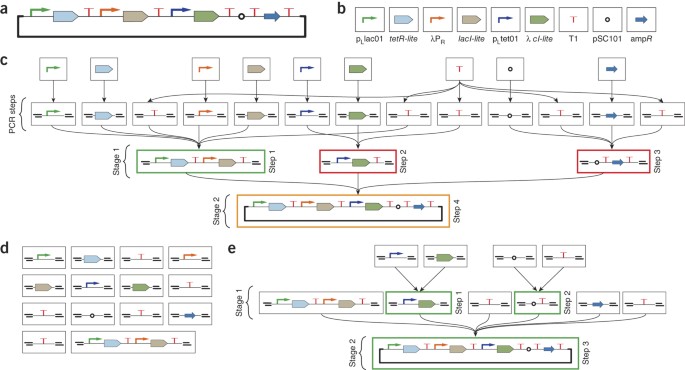
- Select a language for the TTS:
- UK English Female
- UK English Male
- US English Female
- US English Male
- Australian Female
- Australian Male
- Language selected: (auto detect) - EN
Play all audios:
ABSTRACT Molecular biologists routinely clone genetic constructs from DNA segments and formulate plans to assemble them. However, manual assembly planning is complex, error prone and not
scalable. We address this problem with an algorithm-driven DNA assembly planning software tool suite called Raven (http://www.ravencad.org/) that produces optimized assembly plans and allows
users to apply experimental outcomes to redesign assembly plans interactively. We used Raven to calculate assembly plans for thousands of variants of five types of genetic constructs, as
well as hundreds of constructs of variable size and complexity from the literature. Finally, we experimentally validated a subset of these assembly plans by reconstructing four
recombinase-based 'genetic counter' constructs and two 'repressilator' constructs. We demonstrate that Raven's solutions are significantly better than unoptimized
solutions at small and large scales and that Raven's assembly instructions are experimentally valid. Access through your institution Buy or subscribe This is a preview of subscription
content, access via your institution ACCESS OPTIONS Access through your institution Subscribe to this journal Receive 12 print issues and online access $259.00 per year only $21.58 per issue
Learn more Buy this article * Purchase on SpringerLink * Instant access to full article PDF Buy now Prices may be subject to local taxes which are calculated during checkout ADDITIONAL
ACCESS OPTIONS: * Log in * Learn about institutional subscriptions * Read our FAQs * Contact customer support SIMILAR CONTENT BEING VIEWED BY OTHERS GOLDEN EGG, A SIMPLIFIED GOLDEN GATE
CLONING SYSTEM TO ASSEMBLE MULTIPLE FRAGMENTS Article Open access 25 October 2024 A FRAMEWORK TO EFFICIENTLY DESCRIBE AND SHARE REPRODUCIBLE DNA MATERIALS AND CONSTRUCTION PROTOCOLS Article
Open access 24 May 2022 SINGLE 3′-EXONUCLEASE-BASED MULTIFRAGMENT DNA ASSEMBLY METHOD (SENAX) Article Open access 07 March 2022 REFERENCES * Gibson, D.G. et al. Enzymatic assembly of DNA
molecules up to several hundred kilobases. _Nat. Methods_ 6, 343–345 (2009). Article CAS Google Scholar * Weber, E., Engler, C., Gruetzner, R., Werner, S. & Marillonet, S. A modular
cloning system for standardized assembly of multigene constructs. _PLoS ONE_ 6, e16765 (2011). Article CAS Google Scholar * Li, M.Z. & Elledge, S.J. Harnessing homologous
recombination _in vitro_ to generate recombinant DNA via SLIC. _Nat. Methods_ 4, 251–256 (2007). Article CAS Google Scholar * Quan, J. & Tian, J. Circular polymerase extension cloning
of complex gene libraries and pathways. _PLoS ONE_ 4, e6441 (2009). Article Google Scholar * Engler, C., Kandzia, R. & Marillonnet, S. A one pot, one step, precision cloning method
with high throughput capability. _PLoS ONE_ 3, e3647 (2008). Article Google Scholar * Sarrion-Perdigones, A. et al. GoldenBraid: an iterative cloning system for standardized assembly of
reusable genetic modules. _PLoS ONE_ 6, e21622 (2011). Article CAS Google Scholar * Endy, D. Foundations for engineering biology. _Nature_ 438, 449–453 (2005). Article CAS Google
Scholar * Arkin, A. Setting the standard in synthetic biology. _Nat. Biotechnol._ 26, 771–774 (2008). Article CAS Google Scholar * Densmore, D. et al. Algorithms for automated DNA
assembly. _Nucleic Acids Res._ 38, 2607–2616 (2010). Article CAS Google Scholar * Blakes, J. et al. A heuristic for maximizing DNA reuse in synthetic DNA library assembly. _ACS Synth.
Biol._ 10.1021/sb400161v (20 February 2014). * Shetty, R.P., Endy, D. & Knight, T.F. Engineering BioBrick vectors from BioBrick parts. _J. Biol. Eng._ 2, 5 (2008). Article Google
Scholar * Hillson, N.J., Rosengarten, R.D. & Keasling, J. j5 DNA assembly design automation software. _ACS Synth. Biol._ 1, 14–21 (2012). Article CAS Google Scholar * Lou, C.,
Stanton, B., Chen, Y.-J., Munsky, B. & Voigt, C.A. Ribozyme-based insulator parts buffer synthetic circuits from genetic context. _Nat. Biotechnol._ 30, 1137–1142 (2012). Article CAS
Google Scholar * Friedland, A.E. et al. Synthetic gene networks that count. _Science_ 324, 1199–1202 (2009). Article CAS Google Scholar * Tabor, J.J. et al. A synthetic genetic edge
detection program. _Cell_ 137, 1272–1281 (2009). Article Google Scholar * Tamsir, A., Tabor, J.J. & Voigt, C.A. Robust multicellular computing using genetically encoded NOR gates and
chemical 'wires'. _Nature_ 469, 212–215 (2011). CAS Google Scholar * Moon, T.S., Lou, C., Tamsir, A., Stanton, B.C. & Voigt, C.A. Genetic programs constructed from layered
logic gates in single cells. _Nature_ 491, 249–253 (2012). Article CAS Google Scholar * Siuti, P., Yazbek, J. & Lu, T.K. Synthetic circuits integrating logic and memory in living
cells. _Nat. Biotechnol._ 31, 448–452 (2013). Article CAS Google Scholar * Bonnet, J., Yin, P., Ortiz, M.E., Subsoontorn, P. & Endy, D. Amplifying genetic logic gates. _Science_ 340,
599–603 (2013). Article CAS Google Scholar * Bonnet, J., Subsoontorn, P. & Endy, D. Rewritable digital storage in live cells via engineered control or recombination directionality.
_Proc. Natl. Acad. Sci. USA_ 109, 8884–8889 (2012). CAS Google Scholar * Elowitz, M.B. & Leibler, S. A synthetic oscillatory network of transcriptional regulators. _Nature_ 403,
335–338 (2000). Article CAS Google Scholar * Bhatia, S. & Densmore, D. Pigeon: a design visualizer for synthetic biology. _ACS Synth. Biol._ 2, 348–350 (2013). Article CAS Google
Scholar * Peccoud, J. et al. Essential information for synthetic DNA sequences. _Nat. Biotechnol._ 29, 22 (2011). Article CAS Google Scholar * Bilitchenko, L. et al. Eugene: a domain
specific language for specifying and constraining synthetic biological parts, devices, and systems. _PLoS ONE_ 6, e18882 (2011). Article CAS Google Scholar * Wright, D.A. et al.
Standardized reagents and protocols for engineering zinc finger nucleases by modular assembly. _Nat. Protoc._ 1, 1637–1652 (2006). Article Google Scholar Download references
ACKNOWLEDGEMENTS The authors would like to thank S. Bhatia, N. Hillson, E. Oberortner and V. Vasilev for conversations regarding the algorithm development. We also thank M. Smanski
(Massachusetts Institute of Technology), S. Iverson (Boston University) and the Boston University iGEM team for providing samples and for conversations regarding MoClo cloning experiments.
We would like to thank the authors of work from which this work was extended and all alpha-testers of the Raven software. Finally, we would like to thank T.K. Lu (Massachusetts Institute of
Technology), C. Voigt (Massachusetts Institute of Technology) and D. Endy (Stanford University) for providing samples of the genetic constructs that were used to implement assembly plans.
This work has been funded by the Office of Naval Research under grant no. N00014-11-1-0725. AUTHOR INFORMATION AUTHORS AND AFFILIATIONS * Graduate Program in Bioinformatics, Boston
University, Boston, Massachusetts, USA Evan Appleton & Douglas Densmore * Center of Synthetic Biology, Boston University, Boston, Massachusetts, USA Evan Appleton, Traci Haddock &
Douglas Densmore * Bioinformatics and Systems Biology Graduate Program, University of California, San Diego, La Jolla, California, USA Jenhan Tao * Department of Electrical and Computer
Engineering, Boston University, Boston, Massachusetts, USA Douglas Densmore Authors * Evan Appleton View author publications You can also search for this author inPubMed Google Scholar *
Jenhan Tao View author publications You can also search for this author inPubMed Google Scholar * Traci Haddock View author publications You can also search for this author inPubMed Google
Scholar * Douglas Densmore View author publications You can also search for this author inPubMed Google Scholar CONTRIBUTIONS E.A., J.T. and D.D. developed the algorithms. E.A. and J.T.
implemented the algorithms and user interface. E.A. and T.H. designed and performed experiments. T.H. developed standard MoClo protocols and provided materials. E.A., J.T., T.H. and D.D.
wrote the paper. CORRESPONDING AUTHOR Correspondence to Douglas Densmore. ETHICS DECLARATIONS COMPETING INTERESTS D.D. is a co-founder of Lattice Automation, Inc, a company that produces
biodesign automation software. SUPPLEMENTARY INFORMATION SUPPLEMENTARY TEXT AND FIGURES Supplementary Figures 1–12, Supplementary Table 1 and Supplementary Note (PDF 12815 kb) SUPPLEMENTARY
TABLE 2 List of all 4-bp overhang sequences and their reverse complements (*) for modular overhang assignment (XLSX 13 kb) SUPPLEMENTARY SOFTWARE Raven pseudocode and data files (ZIP 241 kb)
SOURCE DATA SOURCE DATA TO FIG. 1 RIGHTS AND PERMISSIONS Reprints and permissions ABOUT THIS ARTICLE CITE THIS ARTICLE Appleton, E., Tao, J., Haddock, T. _et al._ Interactive assembly
algorithms for molecular cloning. _Nat Methods_ 11, 657–662 (2014). https://doi.org/10.1038/nmeth.2939 Download citation * Received: 27 November 2013 * Accepted: 07 April 2014 * Published:
28 April 2014 * Issue Date: June 2014 * DOI: https://doi.org/10.1038/nmeth.2939 SHARE THIS ARTICLE Anyone you share the following link with will be able to read this content: Get shareable
link Sorry, a shareable link is not currently available for this article. Copy to clipboard Provided by the Springer Nature SharedIt content-sharing initiative




:max_bytes(150000):strip_icc():focal(726x0:728x2)/kardashian-dash-stores-1-7e97a1f8224a4227a5869567be2e0725.jpg)



